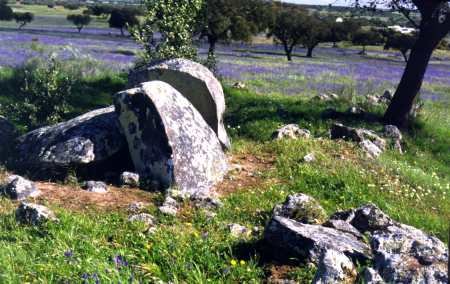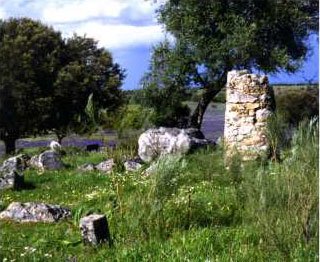

Home > Thinking the Past
The life-history of a monument: a new field of research
The Monte da Igreja project adopts a life-history approach to an archaeological investigation of a Neolithic passage-grave. This means that evidence from all periods is considered equally interesting and thus taken equally seriously.
| Investigating the
'life-histories' (or 'biographies') of prehistoric monuments is an innovative
area of archaeological research. In recent years such research attracted
increasing interest. Archaeologists emphasised how prehistoric monuments
imposed their presence on the landscape, inviting both re-interpretations and re-uses for many millennia after they were built (see Oliveira 2000; Holtorf 2000-2001). |
 |
Until now, most work of
this kind has been based either on archaeological reports and secondary
literature or on the sites and monuments records in archaeological archives.
Fieldwork specifically investigating later (re-)appropriations of earlier
monuments has only very rarely been carried out and never for that reason
alone, so that other questions have usually taken priority.
The Monte da Igreja Project
seeks to redress the balance by focussing specifically on the history of
a prehistoric monument up until the present. Material evidence from various
periods after the Neolithic was left at the site.
 |
Although all dates are still unconfirmed at this point, finds indicate activities near the megalith in particular during the Roman period, in the 11th century AD (we found an arabic coin) and during the 19th and 20th centuries. Only since relatively recently are archaeological monuments such as this megalith given special significance as ancient tombs and protected by state legislation and institutions such as the Instituto Português de Arqueologia. This contemporary significance and protection reflects attitudes of our time in the long life-history of the site. |
All these phases are represented on distinct locations on the site, and so far there is little in the way of long and complex stratigraphies. It is therefore fair to say that the site is in fact "many sites" - and "many sights".
Often, archaeological investigations are considered a way of finding out about events and processes in past periods, from a present vantage point that is itself removed from the course of history represented by evidence in the ground. However, taking the biographical approach seriously, archaeological fieldwork too can be seen as a major episode in the life-histories of archaeological sites, reflecting some attitudes and practices of our own age. For that reason they need to be taken seriously and given careful attention by any 'biographer' of an archaeological monument. Although we have tried not to leave more than a minimum of material evidence ourselves (e.g. our measuring points and the track to the site used by our vehicles), our own work constitutes the most recent phase of activities on the site.
Click here for a recent newspaper article about our work (published in Público on 28 April 2001; in Portuguese)
Holtorf, Cornelius (2000-2001) Monumental Past. The Life-histories of Megalithic Monuments in Mecklenburg-Vorpommern (Germany). Electronic monograph. University of Toronto: Centre for Instructional Technology Development.
Oliveira, Catarina (2000) Lugares de memória. Testemunhos megalitíticos e leituras do passado em Montemor-o-Novo. Historia (February), 56-67.
Webdesign © M E Chester-Kadwell 2001